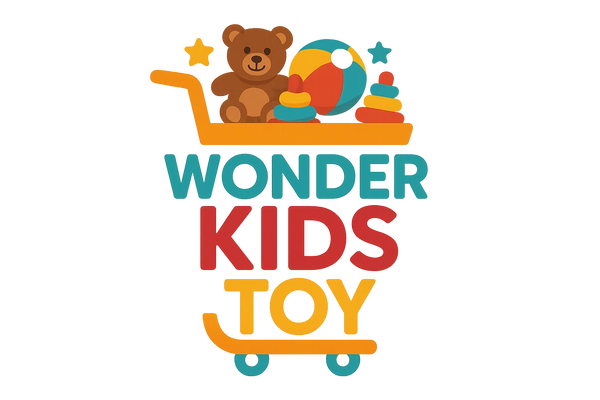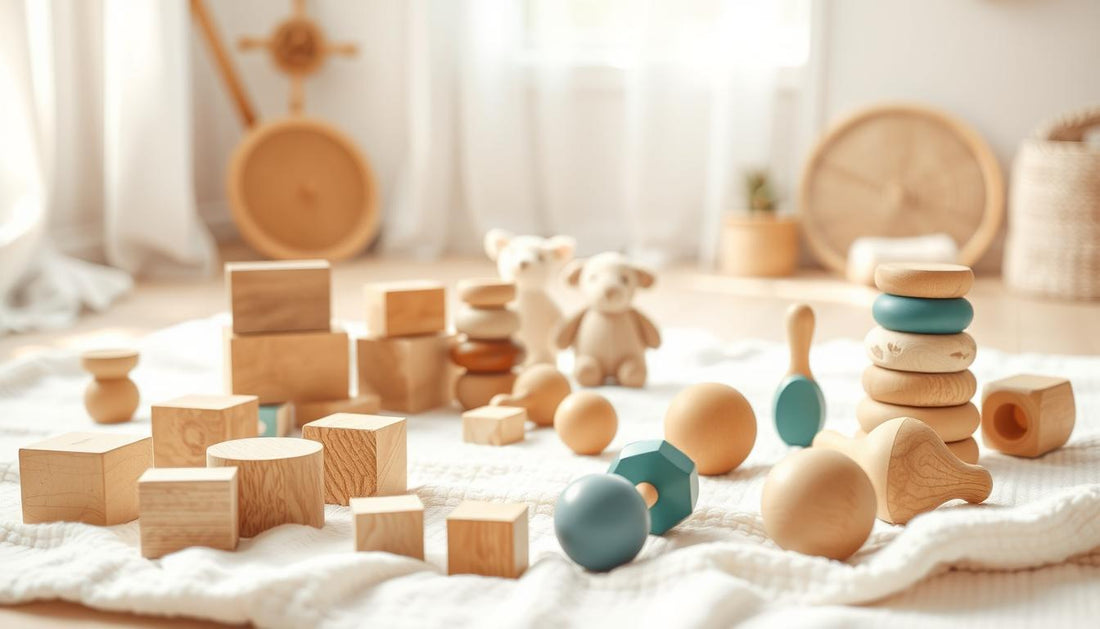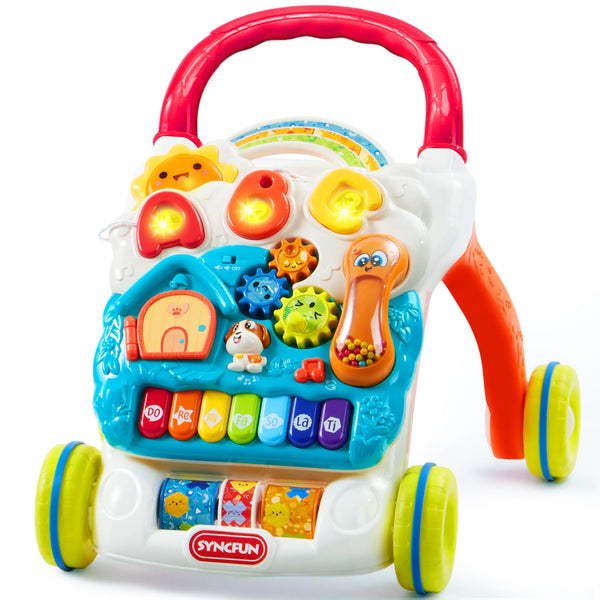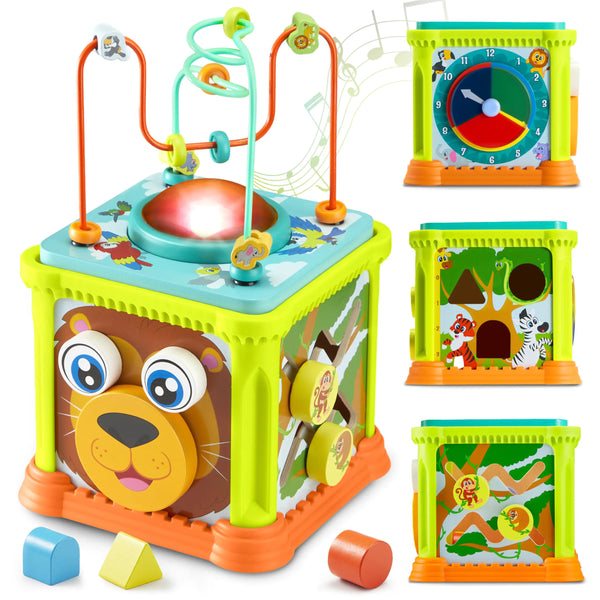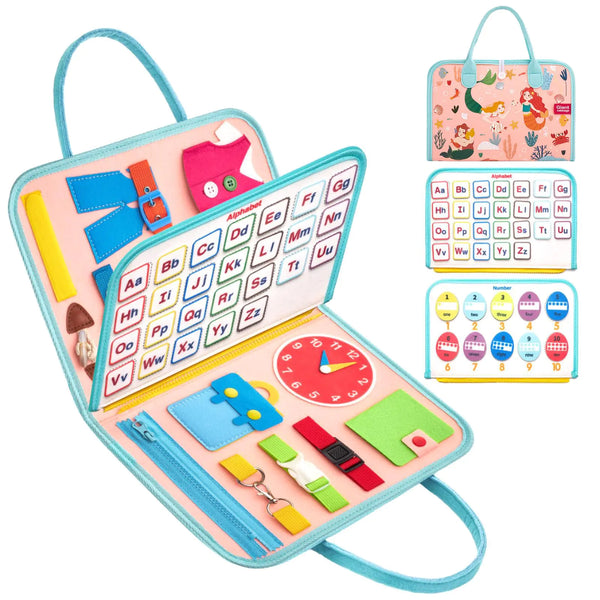As a parent, I'm always searching for ways to help my child grow. Montessori baby toys have caught my eye. They're made to help kids become independent, curious, and learn through play.

Montessori baby toys aim to boost early childhood development. They focus on skills like thinking, moving, and sensing. These toys create a world where kids can explore and learn.
What makes these toys special is their simplicity. They let kids play on their own, which is key to learning.
Key Takeaways
- Montessori baby toys promote independent play and learning.
- They support cognitive, motor, and sensory development.
- These toys encourage self-directed exploration and discovery.
- Simple designs help children focus on the task at hand.
- Montessori toys are designed to adapt to a child's developmental stage.
The Montessori Philosophy for Babies
The Montessori philosophy for babies is all about growing independence and curiosity. Dr. Maria Montessori created it. It focuses on learning by doing, allowing the child to progress at their own pace.
Core Principles of the Montessori Approach
The Montessori method has key principles for babies.
Child-Led Learning
This idea lets kids lead their learning. It allows them to explore and learn at their own speed. Child-led learning builds confidence and independence.
Respect for Natural Development
Montessori respects how each child grows. It knows that every child learns at their own pace. This determines the activities and materials chosen.
How Montessori Differs from Conventional Toy Philosophy
The Montessori approach to toys is distinct. It values quality over quantity and the purpose of each material.
Quality Over Quantity
Montessori prefers a few, high-quality toys over many. This leads to deeper play and learning.
Purpose Behind Each Material
Every Montessori toy or material has a special purpose. It aims to help with thinking, moving, or feeling.
| Aspect | Montessori | Conventional |
|---|---|---|
| Focus | Quality, Educational Purpose | Entertainment, Variety |
| Material Selection | Natural Materials, Durability | Often Plastic, Less Emphasis on Durability |
| Learning Approach | Self-Directed, Hands-On | Often Adult-Directed |
Why Simple is Best: The Power of Montessori Baby Toys in Early Childhood
Simple Montessori baby toys are great because they help kids grow without too much stimulation. Today, many baby toys are overly complicated and overly reliant on technology. But the Montessori way is all about keeping things simple and using natural stuff.
The Problem with Overstimulation
Today's world is full of toys that are too much for babies. These toys light up, make noise, and grab all the attention. This can overwhelm a baby's senses.
Impact on Attention Span
Too many toys can mess with a baby's focus. When toys change or make noise all the time, it's hard for a baby to stick with one thing.
Effects on Sleep and Mood
Too much stimulation can also mess with a baby's sleep and mood. But a calm, simple place helps them sleep better and feel more peaceful.
How Simplicity Promotes Focus and Concentration
Montessori toys, made from things like wood and cotton, are a calm choice. They help kids connect with their world.
Single-Purpose Design Benefits
Montessori toys are designed for a specific purpose. This helps kids learn about cause and effect and how to solve problems.
Deeper Engagement with Materials
Playing with simple, well-made toys helps kids become familiar with the materials. This boosts their thinking skills.
Some big pluses of simple Montessori toys are:
- They help kids focus better
- They cut down on too much stimulation
- They make kids connect with what they're playing with
- They help kids learn and think through simple, clear designs
Choosing simple, natural toys helps parents make a safe space for their kids to grow.
Developmental Benefits of Montessori Toys
Montessori toys are great for infants. They help with thinking, moving, and feeling. These toys help kids grow and learn, setting them up for school and life.
Cognitive Development
Thinking skills are crucial for kids, and Montessori toys play a significant role in their development. They make kids think, learn, and solve problems.
Problem-Solving Skills
Simple puzzles and shape sorters are suitable for kids. They teach kids to think and find answers. This helps kids get better at solving problems later on.
Cause and Effect Understanding
Some toys show how actions lead to results. For example, rattles and object permanence boxes. This teaches kids about cause and effect, which is essential for learning.
Motor Skills Enhancement
Montessori toys also help with moving. Kids get better at small and big movements. This is good for their body.
Fine Motor Development
Grasping toys like soft blocks or sensory balls is great. They help kids strengthen their hands and fingers. This is important for writing and other skills.
Gross Motor Coordination
Push-pull toys help kids move better. They help kids balance and get stronger. This is beneficial for their overall health.
Sensory Development
Sensory toys are also important. They help kids understand the world better. These toys make kids feel, see, and hear more.
Tactile Exploration
Textured toys like fabric books or sensory mats are great. They help kids feel different things. This is good for learning and moving.
Visual and Auditory Discrimination
Montessori toys with colors and sounds are also good. They help kids see and hear better. This makes kids more intelligent and more aware.
In conclusion, Montessori toys are very helpful for kids. They help with thinking, moving, and feeling. Using these toys helps kids grow strong and ready for the future.
Essential Characteristics of Montessori Baby Toys
Montessori baby toys are made with care and thought. They help babies learn on their own, explore with their hands, and grow. These toys are key to a baby's development.
Natural Materials
These toys use natural materials like wood and cotton. These materials are not only good for the planet but also feel nice to touch.
Wood, Cotton, and Other Organic Materials
Wooden toys feel warm and natural. Cotton toys, like soft ones or cloth books, are soft and safe for babies.
Sensory Benefits of Natural Textures
Natural materials like wood and cotton help babies feel and understand their world. They encourage babies to explore and learn.
Purpose-Driven Design
Montessori toys are designed to teach specific concepts. This purpose-driven design helps babies learn new skills and ideas.
Isolation of Difficulty
Montessori toys focus on one thing at a time. This isolation of difficulty helps babies learn and grow step by step.
Self-Correcting Features
Many Montessori toys have self-correcting features. These features enable babies to learn by trying and making mistakes, which helps them solve problems.
Child-Led Learning Features
Montessori baby toys support child-led learning. They let babies learn and explore at their own pace.
Open-Ended Play Possibilities
Toys with open-ended play possibilities let babies use their imagination. They can change the toy as they grow and learn.
Adaptability to Development Stages
Montessori toys can be used in many ways as babies grow. They adapt to the child's changing skills and needs.
| Characteristic | Benefit |
|---|---|
| Natural Materials | Sensory stimulation and sustainability |
| Purpose-Driven Design | Develops specific skills and understandings |
| Child-Led Learning Features | Encourages independent exploration and learning |
Montessori Toys for Newborns (0-3 months)
Montessori toys for newborns focus on simplicity and sensory stimulation. Babies start to explore the world at this age. The right toys can significantly help their growth.
Visual Mobiles and Contrast Cards
Visual mobiles are key for newborns. They grab a baby's attention and boost their visual skills.
Munari Mobile and Its Benefits
The Munari mobile is a classic. It has black, white, and gray shapes. This mobile helps babies track moving objects better.
Black and White Contrast Materials
Black and white contrast cards are also great. They offer high contrast that newborns find interesting. This helps their vision grow.
Rattles and Grasping Toys
Rattles and grasping toys are vital for hearing and motor skills. They encourage babies to move and explore.
Bell Cylinders and Interlocking Discs
Bell cylinders produce a soft sound when they are moved. Interlocking discs improve hand-eye coordination.
Natural Wooden Rattles
Natural wooden rattles are a good choice. They're made from sustainable materials and sound soothing.
My Top Recommendations for Newborns
Choosing Montessori toys for newborns is essential. Look for safe, durable, and natural materials.
| Toy Type | Benefits | Recommended Brands |
|---|---|---|
| Visual Mobiles | Stimulates visual development | Munari, Monti |
| Rattles and Grasping Toys | Enhances auditory and motor skills | Grimms, PlanToys |
| Contrast Cards | Aids in visual development | Lovevery, Montessori Store |
Choosing the right Montessori toys helps newborns grow in a stimulating environment.
Montessori Toys for Babies (3-6 months)
Babies from 3 to 6 months grow curious and start to explore their world. It's essential to give them the right toys. These toys help them learn through touch and movement.
Object Permanence Boxes
Object permanence boxes are key for this age. They teach babies that things continue to exist even when they can't see them.
How They Support Cognitive Development
These boxes help babies learn about objects that stay hidden. This skill is essential for solving problems and remembering things.
Different Types and Variations
There are many kinds of object permanence boxes. Some have one spot, others have many. They can be made of wood, fabric, or other materials.
Sensory Balls and Exploration Toys
Sensory balls are vital for babies aged 3-6 months. They come in different textures, sizes, and colors. This gives babies a rich sensory experience.
Texture Balls and Their Benefits
Texture balls with different surfaces help babies explore and feel textures. They encourage babies to explore and learn about different textures. This boosts their sense of touch.
Simple Grasping Materials
Simple toys like rattles or soft toys help babies improve their motor skills. They learn to reach, grasp, and release objects.

My Top Recommendations for 3-6 Month Olds
Choosing the right Montessori toys for 3-6-month-olds is key. Here are some top picks:
Best Value Options
| Toy | Price | Features |
|---|---|---|
| Object Permanence Box | $15 | Made from natural wood, with a simple design |
| Sensory Ball Set | $20 | Various textures, BPA-free |
| Grasping Toy | $10 | Soft, easy to grasp, washable |
Investment Pieces Worth Splurging On
If you're looking to spend more, consider toys made from sustainable materials. A well-made object permanence box from sustainable wood is a great choice.
"The best toys are those that encourage learning and development in a fun and engaging way." -
Montessori Toys for Babies (6-9 months)
Babies from 6 to 9 months grow more curious and active. They start to understand cause and effect, improve hand-eye coordination, and solve problems. Choosing the right Montessori toys is key at this stage.
Cause and Effect Toys
Cause-and-effect toys are vital for this age. They show babies that their actions can change things. Simple ball drops and coin boxes are great examples, teaching and entertaining at the same time.
Simple Ball Drops and Coin Boxes
These toys are perfect for showing cause and effect. They encourage babies to try new things and learn from their actions.
Musical Instruments for Babies
Baby-friendly drums or xylophones introduce babies to music. They help develop their hearing skills.
Simple Puzzles and Stacking Toys
Simple puzzles and stacking toys boost problem-solving and hand-eye coordination. They come in many forms, like single-shape puzzles and stacking rings or cups.
Single-Shape Puzzles
Single-shape puzzles introduce problem-solving. They teach babies how pieces fit into spaces.
Stacking Rings and Cups
Stacking rings and cups improves fine motor skills. They also teach about size and order.
My Top Recommendations for 6-9 Month Olds
When picking toys for 6-9-month-olds, look for durability and natural materials. Choose toys that grow with the child.
Developmental Standouts
Look for toys that boost cognitive development, like object permanence boxes. Toys that improve motor skills, like grasping toys, are also great.
Multi-Stage Toys That Grow With Baby
Multi-stage toys are very valuable. They adapt to the child's growing abilities, providing ongoing challenges and learning.
| Toy Type | Developmental Benefit | Age Suitability |
|---|---|---|
| Cause and Effect Toys | Understanding cause and effect | 6-9 months |
| Simple Puzzles | Problem-solving skills | 6-9 months |
| Stacking Toys | Fine motor skills | 6-9 months |
Montessori Toys for Babies (9-12 months)
Babies from 9 to 12 months are full of curiosity. They want to explore everything around them. It's essential to pick the right Montessori toys for them.
At this age, babies learn to move around, improve their hand skills, and begin to understand how things work.
Pull and Push Toys
Pull and push toys help babies move and improve their hand-eye coordination. They help babies become stronger and more balanced.
Walking Wagons and Carts
Walking wagons and carts are great for babies learning to walk. They give support and help babies feel more confident.
Pull-Along Animals and Objects
Pull-along animals and objects are fun and good for babies' fine motor skills. They come in different shapes and materials, giving babies lots of sensory experiences.
Fine Motor Skill Developers
Fine motor skills are crucial for babies to perform tasks that require precision and coordination.
Object Sorting Activities
Object sorting activities help babies solve problems and improve hand-eye coordination. They sort objects by shape, color, or size, which helps their brains grow.
Simple Practical Life Tools
Simple, practical life tools, like wooden spoons or small brooms, teach babies about real-life activities. They help babies become independent and improve their fine motor skills.
My Top Recommendations for 9-12 Month Olds
When picking toys for 9-12-month-olds, focus on ones that help with movement, fine motor skills, and learning new words.
Movement-Supporting Toys
- Push-pull toys like wooden carts or animal figures on wheels
- Activity centers that encourage reaching and moving
Language Development Materials
- Books with simple, colorful images and textures
- Toys that make sounds when manipulated, improving hearing
Creating a Montessori-Friendly Play Environment
Creating a simple yet engaging play space is key in the Montessori method. It promotes self-directed learning. A well-designed environment lets children explore, learn, and develop at their own pace.

Setting Up a Simple Play Space
A simple play space is vital for minimizing distractions and maximizing learning. Think about the layout and organization of the play area.
Floor Bed and Low Shelving
Using a floor bed and low shelving units lets your child easily access toys and materials. This promotes independence. It also encourages your child to move freely and make choices.
Minimalist Approach to Toy Display
Keeping the toy display minimalist helps maintain a clutter-free environment. Rotating toys and keeping only a few out at a time keeps the space engaging and enjoyable for your child.
Toy Rotation System
A toy rotation system is key to keeping your child interested and engaged. It involves changing the toys available to your child to challenge them and prevent boredom.
How to Implement Effective Rotations
To implement an effective toy rotation system, start by categorizing your child's toys into different groups. Then, rotate these groups every few weeks to introduce new toys and retire others.
Signs Your Baby Needs New Materials
Watch for signs that your baby is ready for new materials. Look for losing interest in current toys or demonstrating new skills. Introducing new toys or materials at these times can be very effective.
Accessibility and Independence
Ensuring your child can access materials and toys independently is a key aspect of a Montessori-friendly environment. This involves not only the physical setup but also how you interact with your child.
Child-Sized Furniture
Using child-sized furniture is essential for promoting independence. It allows your child to sit, eat, and play comfortably without adult assistance.
Creating Zones for Different Activities
Creating distinct zones for different activities helps organize the play space and guides your child's play. For example, you can have a reading nook, a play area, and a space for arts and crafts.
DIY Montessori Toys You Can Make at Home
With just a few simple materials, you can make DIY Montessori toys. These toys help your baby learn and grow. The Montessori method is all about learning by doing and exploring on your own.
Simple Sensory Bottles
One of the simplest toys to make is a sensory bottle. These bottles are colorful and have different textures. They grab a baby's attention.
Materials and Assembly Instructions
- Empty plastic bottles
- Water
- Oil
- Food coloring
- Glycerin (optional)
- Glitter, beads, or other small objects
Start by filling the bottle with water and a few drops of food coloring. Then, add oil and small objects like glitter or beads. Adding glycerin makes the objects move more slowly, creating a mesmerizing effect.
Age-Appropriate Fillings
| Age | Fillings |
|---|---|
| 0-6 months | Simple water and oil with food coloring |
| 6-12 months | Add glitter, beads, or small toys |
Homemade Object Permanence Box
An object permanence box is a classic Montessori toy. It teaches babies that objects exist even when they can't see them.
Step-by-Step Construction Guide
- Cut a hole in the side of a wooden box, just large enough for a small toy to fit through.
- Sand the edges to ensure they're smooth.
- Place a small toy inside and let your baby discover it.
Safety Considerations
Make sure the box is made from safe materials. Also, the hole should be just the right size to prevent fingers from getting stuck.
Natural Material Discovery Baskets
Discovery baskets filled with natural materials offer a rich sensory experience. They are great for your baby's development.
Treasure Basket Ideas by Age
- For younger babies (0-6 months): Include soft fabrics, wooden spoons, and natural fibers.
- For older babies (6-12 months): Add more complex textures like pinecones, shells, and various types of wood.
Rotation and Refreshment Schedule
Change the items in the discovery basket every few days. This keeps the experience exciting and engaging for your baby.
Making your own Montessori toys saves money and makes learning more personal. Enjoy the process and be creative!
Sustainable and Eco-Friendly Montessori Toy Options
Parents today want Montessori toys that are good for the planet. They look for toys that are both educational and eco-friendly. The Montessori way, which values simplicity and natural materials, fits perfectly with this need.
Benefits of Natural Materials
Natural materials in Montessori toys are great for kids. They look good and help kids explore and understand things with their hands. This is key for their sense of touch.
Environmental Impact
Using natural materials in toys is better for the Earth. These materials break down easily and need less energy to make. This is unlike plastic, which harms the environment.
Health and Safety Advantages
Toys from natural materials are safer for kids. They don't have harmful chemicals like BPA or phthalates. These chemicals are often found in plastic toys.
Top Sustainable Toy Brands
Many brands now offer eco-friendly Montessori toys. You can find small-batch toymakers and companies that use organic and fair-trade products.
Small-Batch Artisan Toymakers
Artisan toymakers make toys in small batches. This means each toy is made with care. It also supports local economies and results in unique, quality toys.
Certified Organic and Fair Trade Options
Certified organic toys are made without harmful chemicals. Fair-trade toys ensure that the people making them are paid fairly.
| Brand | Material | Certification |
|---|---|---|
| Green Toys | Recycled Plastic | Non-toxic, Eco-friendly |
| Grimm's | Wood, Natural Dyes | Certified Organic |
| PlanToys | Sustainable Wood | ISO 14001:2015 |
Longevity and Heirloom Quality
Montessori values toys that last a long time. These toys can be passed down to future generations. They become family treasures.
Investment vs. Disposable Mentality
Sustainable toys cost more at first. But they are an investment in your child's future. They teach the value of quality over quantity and help reduce waste.
Care and Maintenance for Lasting Use
To make Montessori toys last, teach kids how to take care of them. Simple steps like cleaning and storing toys properly can make them last longer.
Common Mistakes When Choosing Montessori Toys
Choosing Montessori toys can be tough for parents. Knowing common mistakes helps a lot. It's easy to pick the wrong toys, which can slow down your child's growth.
Avoiding Electronic and Battery-Operated Toys
Many parents make the mistake of choosing electronic toys. These toys don't follow the Montessori way.
Why They Contradict Montessori Principles
Electronic toys can be too much for kids. They make it hard for kids to focus and learn at their own pace. Montessori is all about kids learning by themselves and doing hands-on activities.
Alternatives to Popular Electronic Toys
Instead, opt for toys that encourage kids to learn through hands-on activities. Wooden puzzles and stacking toys are great. They match Montessori and make learning fun.
The Pitfall of "Educational" Marketing Claims
Another mistake is believing in "educational" claims that don't fit Montessori.
Red Flags in Toy Descriptions
Be cautious of toys labeled as "educational" or "Montessori-inspired" that don't adhere to Montessori principles. Look for toys with clear learning goals.
How to Identify True Montessori-Aligned Products
To find real Montessori toys, look for natural materials and self-learning design. Check the maker's beliefs and ask other parents for their opinions.
Quality vs. Quantity Considerations
With Montessori toys, it's better to have a few good ones than many bad ones. Quality is more important than the quantity of toys you have.
Building a Thoughtful Collection
Choose toys that are both long-lasting and educational. Think about how the toy will grow with your child.
When to Invest and When to Save
Buy high-quality toys and teach something important. Save money by skipping trendy or complicated toys that don't last.
| Toy Type | Montessori Alignment | Quality Indicators |
|---|---|---|
| Wooden Puzzles | High | Natural materials, durable |
| Stacking Toys | High | Promotes fine motor skills, simple design |
| Electronic Learning Toys | Low | Overly stimulating, battery-dependent |

"The greatest sign of success for a teacher is to be able to say, 'The children are now working as if I did not exist.'" - Maria Montessori
By avoiding these mistakes and making informed choices, parents can help their kids grow and learn in a significant way.
How to Engage With Your Baby Using Montessori Toys
Introducing Montessori toys to your baby is more than just playing. It's building a strong foundation for learning. To engage with your baby, you need to use a thoughtful approach that supports their natural growth.
Observation Techniques
Observation is a key part of Montessori. By watching your baby closely, you can see what they like and what they can do. This helps you tailor your interactions to help them grow.
Recognizing Concentration and Interest
When your baby is into a Montessori toy, watch how long they stay focused. This shows you what they're interested in and helps you pick the right activities.
Documenting Developmental Progress
Keeping a journal of your baby's progress is very helpful. It lets you see how they're growing over time and find areas where they might need extra help.
Encouraging Independent Play
Independent play is a big part of Montessori. It lets your baby explore and learn at their own pace. This helps them develop problem-solving skills and builds confidence.
The Art of Stepping Back
It can be hard for parents to know when to let their baby solve things on their own. But it's crucial for their independence.
Creating Opportunities for Discovery
Offering a variety of Montessori toys and activities lets your baby discover new things. They learn by trying and making mistakes.
When and How to Offer Assistance
While it's good for your baby to play on their own, there are times they'll need your help. Knowing when to give them just enough help is key.
The Concept of "Just Enough Help"
Helping your baby just enough to solve a problem, but not doing it for them, is a delicate balance. It helps them learn and become more resilient.
Modeling vs. Directing Play
There's a difference between showing your baby how to play and telling them what to do. Montessori encourages the former. It lets your baby learn by watching and imitating.
Incorporating Montessori Language During Play
Language is a big part of your baby's growth. Using the right words and talking about what you're doing can help their language skills.
Precise Vocabulary Introduction
When playing, use the correct names for things and actions. This helps your baby build a strong vocabulary from the start.
Narrating Without Interrupting
Talking about what you're doing as you play can be a great way for your baby to learn. It gives them context and helps them understand words and actions.
| Age | Montessori Toy/Activity | Learning Outcome |
|---|---|---|
| 0-3 months | Visual mobiles and contrast cards | Visual development and tracking |
| 3-6 months | Sensory balls and exploration toys | Sensory awareness and motor skills |
| 6-9 months | Cause and effect toys | Understanding causality and problem-solving |
By using Montessori toys and following these tips, you can create a supportive environment for your baby's growth.
Embracing Simplicity for Your Child's Development
Choosing simple toys is a smart way to help our kids grow. Montessori toys provide children with what they need to learn and develop. They help with thinking, moving, and feeling.
We've looked at picking the best toys for babies and toddlers. We discussed using natural materials and toys to help kids learn independently. This way, we help them become independent, focused, and creative.
It can be hard to pick the right toys for our kids. But by choosing simple and high-quality ones, we make a safe space for them to grow. I hope you look into Montessori toys and see how they can help your child.
FAQ
What are the benefits of using Montessori baby toys?
Montessori baby toys help with thinking, moving, and feeling. They also encourage kids to play on their own, solve problems, and get really into what they're doing.
What is the Montessori philosophy, and how does it apply to babies?
The Montessori way is all about kids learning by themselves, respecting how they grow naturally, and choosing quality over quantity. For babies, this means toys that are simple, useful, and help them explore and find out new things.
How do Montessori toys differ from conventional toys?
Montessori toys are easy to use, made from natural materials, and have one main goal. They're different from regular toys, which are often too complicated, made from plastic, and just for fun.
What are some examples of Montessori toys suitable for newborns?
Newborns can enjoy visual mobiles, contrast cards, rattles, and toys made from wood and cotton. These toys help them see, feel, and learn.
How can I create a Montessori-friendly play environment at home?
To create a Montessori play area at home, start by setting up a simple space with a floor bed and low shelves. Use a toy rotation system and make sure everything is easy to reach with child-sized furniture.
What are some DIY Montessori toys I can make at home?
You can create sensory bottles, object permanence boxes, and discovery baskets using materials like water, oil, and natural fibers. It's a fun way to make learning toys at home.
Why are natural materials and sustainable toys essential in Montessori?
Natural and eco-friendly toys are key in Montessori because they help kids play in a healthy, green way. They also make play more interesting and meaningful.
How can I engage with my baby using Montessori toys?
To connect with your baby through Montessori toys, observe their interests and focus areas, let them play independently, and offer assistance only when needed. Also, use Montessori language when playing.
What are some common mistakes to avoid when choosing Montessori toys?
Don't pick electronic or battery toys, don't buy too many, and don't believe everything you see in ads. Stick to real, quality toys that help kids learn.
How can I ensure that I'm providing the best Montessori toys for my baby's developmental stage?
To pick the right Montessori toys for your baby, observe their capabilities and interests. Choose toys that match their age, like object permanence boxes for younger babies or toys that help them move for older ones.

